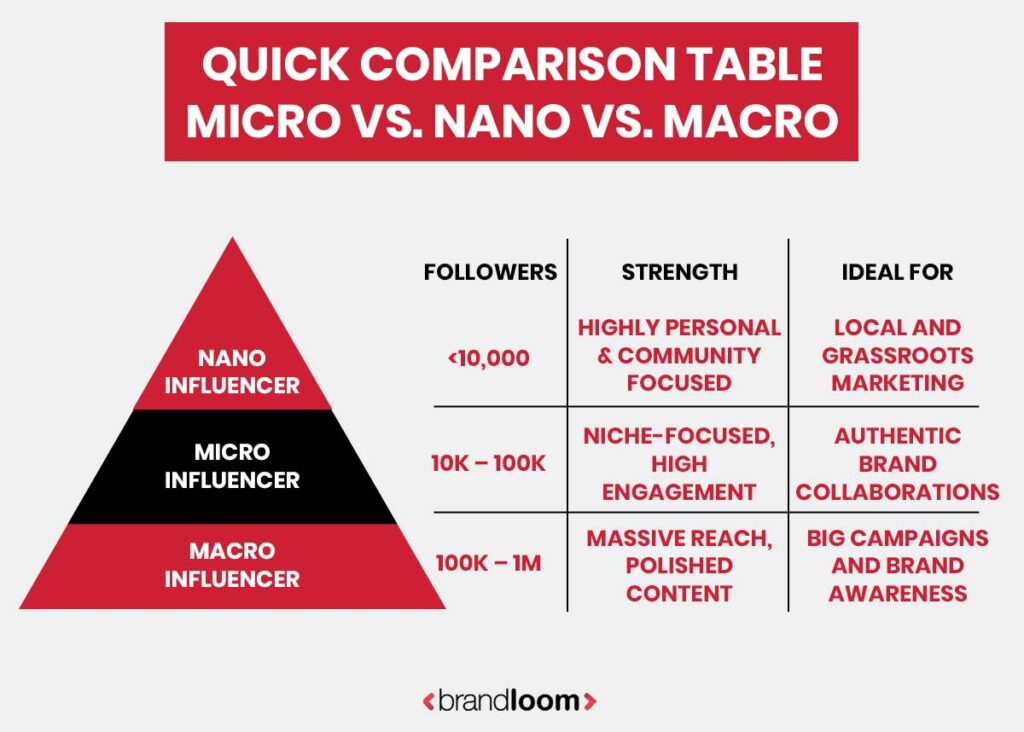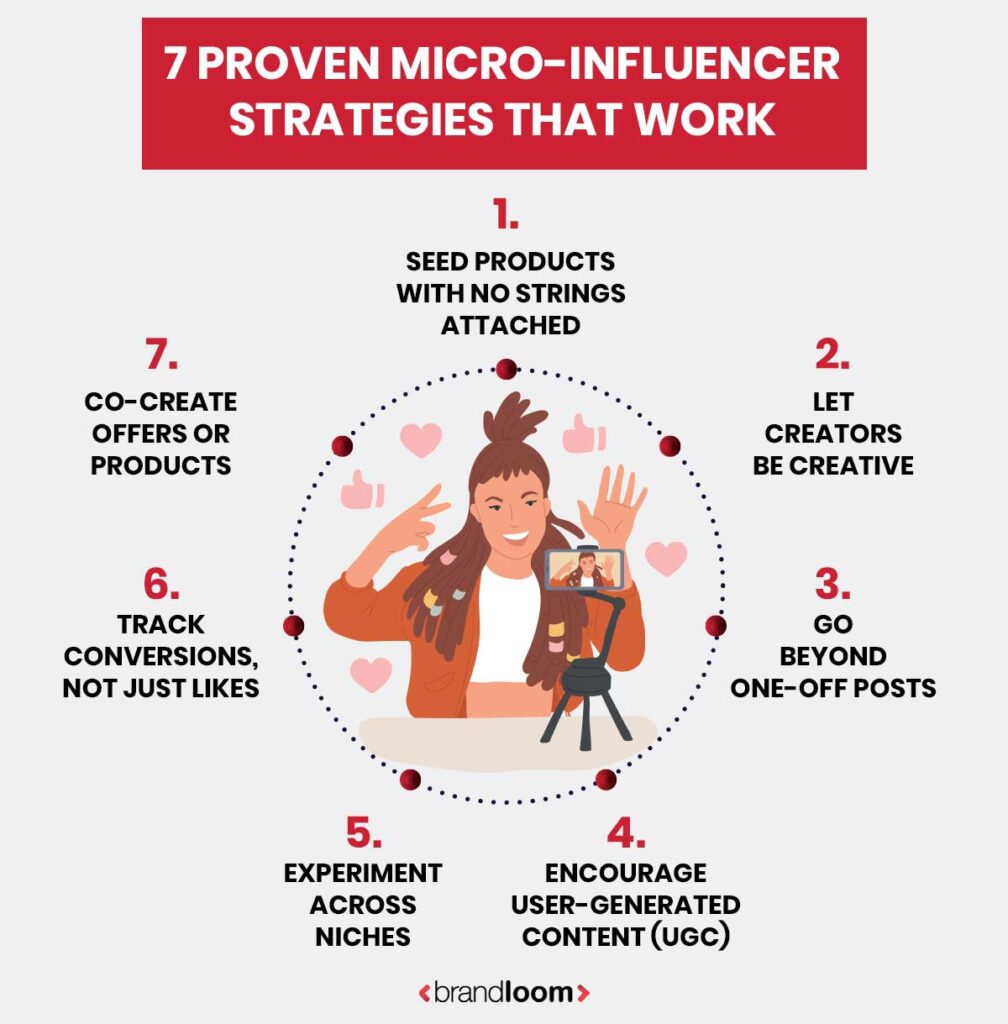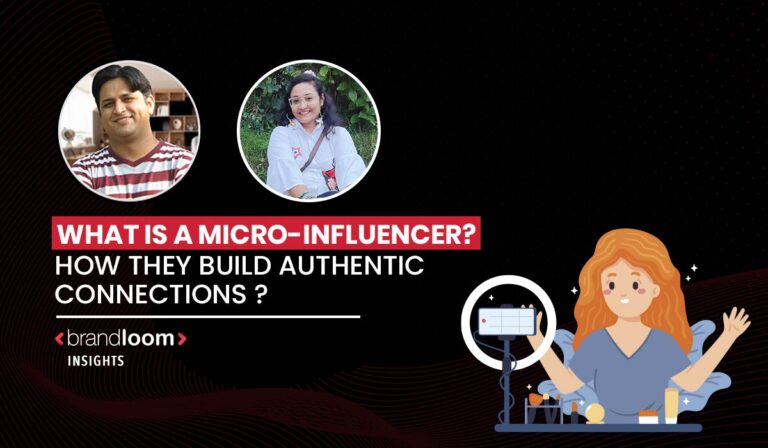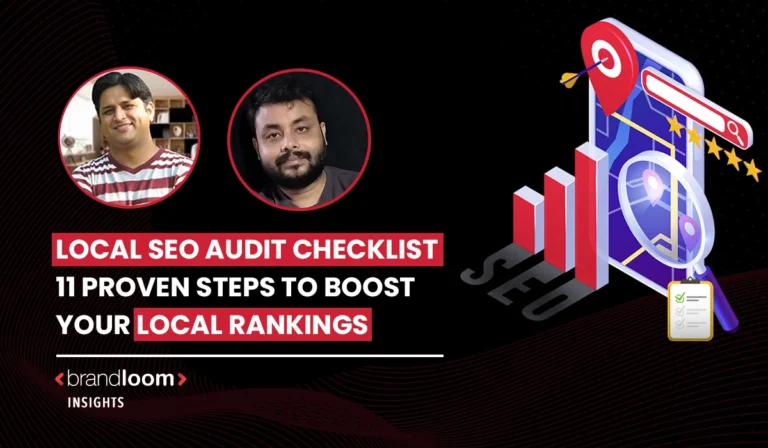A person can be an influencer even if they are not well-known. An interesting fact is that some of the most trustworthy people on the internet are regular people who have small but devoted fan bases. Micro-influencers are the people who make these kinds of videos, but if you’re wondering what is a micro-influencer, they’re individuals with small but loyal followings who create authentic, niche content. Their real and honest videos get them a lot of followers, often between 10,000 and 100,000.
Micro-influencers are more relatable than major celebs. Their suggestions are more reliable as their followers see them as colleagues or friends. Their content seems real, whether they’re reviewing tech, giving health tips, or suggesting beauty products.
We’ll talk about what a micro-influencer is, why companies like working with them, and how they make real, long-lasting links in this piece. Influencer marketing agencies like BrandLoom help brands tap into these powerful connections by identifying the right creators, managing campaigns, and turning authenticity into performance.
What is a Micro-Influencer?
To answer the question ‘what is a micro-influencer,’ think of someone who has between 10,000 to 100,000 followers and creates highly targeted content for a specific community. They usually concentrate on one skill or interest, like fashion, food, cooking, losing weight, technology, parenting, or food.
Micro-influencers are more open and friendly than celebrity influencers or mega-influencers with millions of fans. They get people more involved by using notes, texts, and stories. Because they are so close, their fans often listen to them and buy the things they suggest.
Small-scale leaders create content and expand groups. They have more Instagram, YouTube, and other followers because they are honest, share personal tales, and provide useful recommendations.
Before we dive into why brands love them, it’s important to understand what is a micro-influencer and how their influence works differently compared to traditional celebrities.
RELATED ARTICLES
Uncover what it truly means to be an influencer in today’s digital world. Beyond followers - learn how real influence drive brand growth. Learn All, here.
Discover the top beauty bloggers in India who are redefining skincare, makeup, and beauty trends. Follow these influencers for tips, reviews, and inspiration.
Meet the best Indian food bloggers who are serving up delicious recipes, culinary tips, and regional flavors. Follow them for authentic food inspiration and mouthwatering content.
Stay updated with the latest technology trends through blogs by India’s top tech bloggers. Discover insights, reviews, and innovations shaping the digital future.
Discover the best travel bloggers in India who capture stunning destinations, share expert tips, and inspire your next adventure with their journeys across the country and beyond.
Explore the top 20 Indian fashion bloggers every brand should know. From trendsetters to style influencers, these creators shape what’s next in fashion and consumer influence.
Explore the definitive list of top YouTubers in India, their content styles, subscriber count, and estimated earnings. Get inspired by India’s biggest digital creators.
Explore the Amazon Influencer Program in India—how it works, who can join, and how creators earn by promoting products. Your complete guide to getting started.
Why Brands Love Micro-Influencers?
Marketers are becoming more and more interested in micro-influencers, and for good reason. Micro-influencers sometimes get better results than famous ones, even though they have fewer fans. Why? Because their fans interact with their stuff more and trust them.
Here’s why brands love working with micro-influencers:
- Additional shares, comments, and likes: Compared to larger influencers, micro-influencers often get more of these activities. Because they see their postings as personal, their followers are interested in what they have to say.
- Increased trust: Their suggestions appear genuine rather than like advertisements, as they are seen as actual individuals. Credibility is increased by this.
- More specialized audience: Micro-influencers often talk about specialist topics, including technology, travel, and skin care. They make it easier for companies and their target market to communicate.
- Economical partnerships: Rather than employing a single superstar, collaborating with a small number of micro-influencers may nevertheless provide excellent outcomes at a lesser cost.
- Real content: Brands may find it easier to interact with loyal followers when micro-influencers provide sincere, intimate content.
Micro-influencers help organizations develop, connect with the appropriate people, and create a reputation without spending much on advertising. If you’re looking to get started, BrandLoom can help you find, connect, and collaborate with the right micro-influencers for your niche, ensuring your message is trusted, not just seen.
Micro-Influencers vs Nano- and Macro-Influencers – Know the difference
Once you understand what is a micro-influencer, it helps to compare them with nano- and macro-influencers to determine the right fit for your brand.
Influencers vary from one another. They are often categorized according to the kind of influence they have and the number of followers they have.
The differences between micro-, nano-, and macro-influencers are as follows:

1. Nano-Influencers (Less than 1,000 to 10,000 followers)
Nano-influencers are daily users of social media who have a small but close-knit group of followers. A lot of their fans are friendly people, and they only support businesses that they really believe in. Companies like them because they have a real say and have an impact on the community, especially for small projects that benefit the community.
Best for: Hyper-local marketing and word-of-mouth buzz
2. Micro-Influencers (10,000 to 100,000 followers)
They are excellent at attracting many viewers and participants. Followers often become close friends and consider them as parenting, technology, health, or beauty gurus. They’re fantastic for organizations that wish to engage with loyal consumers cheaply.
Best for: Niche-focused, high-engagement campaigns
3. Macro-Influencers (100,000 to 1 million+ followers)
Many individuals follow celebrities, public figures, and internet artists. Despite receiving a lot of attention, they may not have as much interaction as micro and nano influencers. Despite the expense, big firms cooperate with macro-influencers on national or global initiatives.
Best for: Large-scale brand awareness
Brands may choose the best influencer for their budget, marketing objectives, and audience type by being aware of the differences.
If you’re still thinking about what is a micro-influencer and why their influence matters, it all comes down to the authentic connections they build with their communities.
The Power of Authentic Connections
A good way for micro-influencers to help their followers is to get to know them on a human level. Unlike traditional ads or famous recommendations, micro-influencers give information in a way that is interesting, real, and honest.
As these creators offer their candid opinions, behind-the-scenes videos, and personal tales, people begin to trust them more. Their followers see them as actual persons with real-life circumstances in addition to being content producers. Stronger loyalty, more involvement, and greater purchasing power result from this emotional bond.
Actually, research indicates that even if a product is recommended by someone you know personally, even if they don’t have many followers, people are more inclined to believe them. Micro-influencers provide both reach and connection depth, which makes them incredibly beneficial.
This means that marketers who work with micro-influencers might be able to get more relevant talks and higher sales rates. This is especially true when they are trying to sell niche or lifestyle goods. Being honest makes people trust you, which is very important at work these days.
Micro-Influencer Marketing Strategies That Work
You can’t provide micro-influencers freebies and expect reviews. For optimum outcomes, businesses must adopt well-thought-out tactics that showcase these leaders’ true traits.
Here are some of the most effective ways to partner with micro-influencers:

1. Product Seeding With No Strings Attached
Brands may provide things to influencers without requiring content, rather than requesting instant promotion. If the promoter really likes the product, it makes people like it more, which often leads to accidental, free shoutouts. It also keeps the topic from coming off as forced or planned ahead of time.
2. Give Influencers Creative Freedom
The greatest people to know their audience are micro-influencers. Instead of enforcing strict guidelines, let individuals tell your brand’s story in their own terms. Whether via reviews, unboxings, lectures, or personal experiences, authentic storytelling looks more authentic and draws in followers.
3. Use Long-Term Partnerships, Not One-Off Posts
One-time partnerships may seem like a transaction. Rather, cultivate enduring connections with influencers to integrate your brand into their regular material. This consistency maintains your goods at the forefront of your audience’s mind and builds trust.
4. Encourage User-Generated Content (UGC)
Request that influencers ask their followers to tell you about their own product experiences. This broadens your audience and starts a chain reaction of peer-to-peer material. Credibility is also increased by reposting this user-generated content on your brand’s page.
5. Run Micro-Influencer Campaigns Across Niches
You should not limit yourself to a single type of material or leader. If you want your ads to perform better, try experimenting with a few acts in related fields, such as parenting, fitness, technology, or beauty, to see what your audience likes best. The best thing is to get in touch with tech micro-influencers, fashion influencers, and other micro creators as well.
6. Track Engagement and Conversions, Not Just Likes
Use promo coupons, partner links, or UTM links to see how well something performed. Micro-influencers care more about quality than quantity. That’s why keeping track of interactions (like likes, shares, and saves) and sales gives a truer picture of return on investment.
7. Co-Create Products or Campaigns
Consider including micro-influencers in product design, naming, or special offers for more meaningful brand-influencer connections. This makes the influencer a brand advocate and boosts brand loyalty.
Companies can get the most out of micro-influencer marketing by using smart strategies like these. The material should still focus on results, relationships, and openness.
How Micro-Influencers Build Trust and Engagement?
Skilled influencers establish trust. Unlike celebrities and huge content creators, micro-influencers establish their image by connecting with people, sharing meaningful material, and conducting charitable work.
Here’s how they do it:
1. They Speak Honestly
Honest thoughts are a hallmark of micro-influencers. Not everything that comes their way is promoted. Most products they recommend are ones they use and support. Because of this candor, followers trust their advice.
2. They Share Personal Stories
Micro-influencers don’t share pre-written content; instead, they talk about how a product or service fits into their everyday life. People can relate to the leader more deeply when the style is story. It also makes the word about the brand seem more real and less like ads.
3. They Engage With Their Audience
Micro-influencers provide fan material, answer questions, respond to comments, and direct messages. Feeling like part of a group and having their voice heard and respected increases trust.
4. They Stay Consistent and Focused
The majority of micro-influencers focus on a single area, such as fitness, parenting, travel, or beauty. They draw a devoted, like-minded audience since their work has a defined emphasis. This emphasis gradually establishes their reputation and establishes them as reliable authorities in their field.
5. They Show Behind-the-Scenes Moments
Ads that look good don’t seem as real as real people. Micro-influencers post unedited bloopers, behind-the-scenes, and everyday life films. Being honest with your audience might help you overcome issues and connect with them.
As a whole, these micro-influencer actions help people believe them, which turns businesses into reliable partners and casual followers into die-hard fans.
How to Find and Work with Micro-Influencers?
To find the right micro-influencer and work well with them, you need to do more than just look at how many people follow them. Brands should put usefulness, connection, sincerity, and honest talk first in a relationship if they want to get the most out of it.
1. Know Your Audience First
Now that you know who to speak to, find micro-influencers. Do you want to target busy mothers, college students, health-conscious teenagers, or tech-savvy kids? Finding leaders to assist you in achieving your objective is simpler if you know what you want. You may contact celebrity fans who trust and care about what you say.
2. Use Smart Discovery Tools and Platforms
Using tools made just for this reason can help you find the right micro-influencers. On sites like Heepsy, Collabstr, Upfluence, and AspireIQ, you can sort leaders by business, location, user groups, and interaction rates. With these tools, you can learn more than just from social media. You can find great Indian talent in fashion, beauty, food, and technology on sites like Wobb, OPA, and One Impression if you want to work with Indian micro-influencers.
3. Focus on More Than Just Follower Count
It’s easy to see how many fans you have, but that’s not the most important thing. How involved a promoter is with their community is the most important thing. It’s possible for a micro-influencer with 8,000 loyal and busy followers to make a bigger difference than one with 50,000 idle followers. Check to see if they respond to fans, how often they get smart comments, and if the content they post fits with the goals of your business. Find out if they’ve worked with other businesses before and how well their ads fit with the content of those businesses.
4. Reach Out With a Personal and Professional Approach
Send them a message that is polite and seems personal once you have found the right influencers. How do you think your brand will fit in with theirs? What do you like about their pages? Use fewer words and sound more serious. Trade items, buy a stamp, or collaborate on a long-term project. Honesty will build trust and improve the workplace.
5. Set Clear Expectations From the Start
As soon as the leader shows interest, write down what you hope to happen. The campaign’s objectives, the quantity of posts or articles created, the dates, the key points, and the intended usage of the content should all be noted. While maintaining organization is important, leaders should also be allowed to use their creativity. Since they are the greatest at communicating with their followers, postings that include forced messages may come out as fake.
6. Build Long-Term Relationships, Not One-Off Deals
The best results for brands can come from ongoing partnerships rather than one-time efforts. People who follow an advocate will be more likely to believe in your product if they hear about it a lot. People will know and believe this brand more if it is shown more often, which could lead to better brand memory and more sales. You should consider friends as long-term partners. Maintain contact, help them, and invite them to join your efforts.
These procedures will help companies locate the ideal micro-influencers and build actual relationships that will develop them. Influencer marketing is just one aspect of it; another is establishing a relationship that is advantageous to the company and the creative.
India’s Micro-Influencer Boom: What Brands Should Know?
Micro-influencers are at the center of a significant change in the way marketers interact with customers in India.
Here’s what every marketer should know about the rise of micro-influencers in India:
1. The Creator Economy is Exploding
India’s creator economy has grown by 322%, now valued at over ₹3,600 crore. With nearly 2 million influencers on Instagram alone, India is the third-largest influencer market globally, right after Brazil and the U.S.
2. Micro-Influencers Drive Higher Engagement
Micro-influencers in India typically have 10,000 to 100,000 followers, but what sets them apart is their engagement rate, averaging 4–6%, much higher than that of macro-influencers (2–3%). Their content feels more personal and trustworthy, which drives better audience interaction.
3. Tier 2 & 3 Cities Are Leading the Growth
More than 75% of Indian influencers now come from smaller cities and towns. This regional shift has brought a boom in vernacular content across Hindi, Tamil, Marathi, Telugu, and other languages, allowing brands to connect with audiences in a more localized and culturally relevant way.
4. Video-First Content is Dominating
With platforms like Instagram Reels and YouTube Shorts gaining popularity, Indian micro-influencers are increasingly using short-form video to tell stories, review products, and share experiences. These videos generate higher shares and better reach, especially among younger audiences.
5. Better ROI at Lower Costs
Micro-influencer campaigns are not only affordable, they’re also highly effective. On average, brands in India are seeing a return of ₹5 for every ₹1 spent. For small and mid-size brands, this makes influencer marketing both accessible and profitable.
6. Trust and Authenticity Drive Conversions
Indian consumers tend to trust influencers who seem “just like them.” Micro-influencers share honest reviews, everyday routines, and relatable experiences. This level of authenticity creates stronger brand recall and leads to higher conversion rates.
7. Challenges Still Exist
Despite the boom, brands must stay alert. Issues like fake followers, low content quality, and misaligned brand-influencer partnerships can affect campaign performance. It’s crucial to vet influencers carefully and track real engagement, not just vanity metrics.
8. The Growth is Just Beginning
The Indian influencer market is projected to reach ₹33.75 billion by 2026, growing at a rate of ~18% CAGR. With more platforms, better tools, and rising internet penetration, micro-influencers will play an even bigger role in shaping consumer choices in the years to come.
Conclusion
Even though micro-influencers don’t have millions of followers, their trust, real influence, and authenticity are significantly more important. People are yearning for relatable, human voices in an internet environment full of filters and advertisements. Micro-influencers provide just that: honest discussions, specialized knowledge, and solid community ties.
Working with micro-influencers is a sensible strategy for companies, not simply a fad. Micro-influencer marketing has shown its effectiveness in a variety of sectors, platforms, and geographical areas, particularly in India, where the business is flourishing due to the availability of relevant producers and localized content.
One thing is certain as influencer marketing develops further: genuineness will always prevail. Additionally, micro-influencers are setting the standard. If your brand is ready to grow through trusted voices and powerful stories, contact a micro-influencer agency like BrandLoom, which can help you make the right connections and build campaigns that truly convert.
FAQs
A micro-influencer is a social media content creator who typically has between 1,000 and 100,000 followers. While they may not have celebrity status, they hold significant power within a specific niche, like beauty, fitness, food, parenting, fashion, or tech.
What sets micro-influencers apart is their close connection with their audience. Their followers often see them as relatable, trustworthy individuals rather than distant public figures. This trust results in higher engagement rates, meaning their posts usually receive more likes, comments, and shares relative to their follower count.
Micro-influencers tend to focus on authentic content, real-life reviews, personal stories, and honest recommendations, which makes their influence stronger when promoting brands or products. Their smaller but more targeted and loyal communities make them ideal partners for businesses that want to reach the right audience in a natural, cost-effective way.
As the top influencer marketing agency, we help brands identify the right micro-influencers for their target audience, ensuring your message reaches real people who trust and engage with the content they see
An influencer is considered authentic when their content feels genuine, honest, and relatable, not overly polished or promotional. Authentic influencers share real experiences, speak in their own voice, and stay true to their personality, even when working with brands.
What sets them apart is their transparency. They openly disclose paid partnerships, give honest opinions (even if they include flaws), and don’t promote every product that comes their way. Their followers trust them because their content reflects real-life use, not just marketing messages.
Authentic influencers also tend to engage actively with their audience; they reply to comments, ask questions, and build a sense of community. This two-way connection makes followers feel seen and heard, further strengthening trust. BrandLoom vets every influencer in its network for authenticity and engagement, so your brand partners with creators who bring credibility, not just visibility.
Connecting with micro-influencers requires a thoughtful and personalized approach. Start by identifying influencers who align with your brand values, audience, and niche. Look at the type of content they create, their engagement rates, and whether their followers match the demographic you want to reach.
Once you’ve shortlisted potential influencers, reach out with a personalized message, either via email or direct message on platforms like Instagram. Avoid generic outreach. Instead, mention why you like their content, how you think your brand fits their style, and what kind of collaboration you’re proposing. A warm, respectful tone goes a long way.
When making your offer, be clear about the expectations, what you’re providing (product, payment, commission), what kind of content you’re looking for (reels, stories, reviews), and the timeline.
Also, let them know if you’re open to their ideas or creative input; they’ll appreciate being treated as partners, not just promoters.
To simplify this, BrandLoom handles end-to-end outreach and relationship management, helping brands build long-term partnerships with micro-influencers across niches.
Authenticity is the backbone of successful influencer marketing. In a world where consumers are constantly exposed to ads, people crave content that feels real, honest, and trustworthy. That’s exactly what authenticity delivers, and it’s why it matters so much.
When an influencer genuinely believes in the product they’re promoting, it shows. Their recommendations feel natural and personal, not scripted or forced. As a result, followers are more likely to listen, engage, and take action, whether that’s visiting a website, trying a product, or sharing the post with others.
Authenticity also helps build long-term trust. If an influencer is consistently honest, their audience sees them as reliable and credible, not someone who’ll promote anything for money. This kind of trust doesn’t just benefit the influencer; it boosts the brand’s image too. At BrandLoom, we prioritize authenticity in every campaign, ensuring that creators tell brand stories in a way that feels natural, personal, and impactful.
Micro-influencers offer several unique advantages that make them a powerful choice for brands, especially those looking for authentic, high-impact marketing without massive budgets.
One of the biggest benefits is higher engagement. Compared to macro-influencers or celebrities, micro-influencers often have a much closer relationship with their audience. Their followers trust them more, interact more, and are more likely to act on their recommendations.
Another advantage is targeted reach. Micro-influencers usually focus on a specific niche, like fitness, skincare, tech, or parenting, so their audience is more concentrated and relevant. This means your brand message reaches the people who actually care about your product or service.
Micro-influencers are also cost-effective. Working with them is generally more affordable than partnering with larger influencers, making it ideal for startups or small businesses. And because of their high engagement, you often get more value for every rupee or dollar spent.
Additionally, their content tends to feel more natural and relatable, which builds trust and improves brand credibility. They’re also easier to work with, often open to flexible collaborations, and can create content that feels like a genuine conversation, not a sales pitch.
BrandLoom, being one of the best influencer marketing agencies in India, helps brands utilize these benefits by designing custom micro-influencer strategies that deliver measurable results, without the mega-influencer price tag.
Yes, micro-influencers do get paid, though the amount and form of compensation can vary widely depending on factors like their follower count, engagement rate, content quality, and the brand’s budget.
Some micro-influencers earn direct payments for sponsored posts, while others may receive free products, discount codes, affiliate commissions, or long-term brand deals. In many cases, especially with smaller brands or startups, the collaboration may start as a barter, where the influencer receives a product in exchange for content. But as their audience grows and they build a professional presence, micro-influencers often begin charging per post or per campaign.
On platforms like Instagram, YouTube, and TikTok, micro-influencers who consistently create engaging content can turn their presence into a reliable income stream.
Some also work with influencer marketing platforms or agencies that help them connect with brands and manage pricing. BrandLoom manages both paid and barter-based influencer campaigns—ensuring clear expectations and fair compensation based on industry standards.
Growing as a micro-influencer takes more than just posting pretty pictures; it’s about building trust, consistency, and connection with your audience over time.
Start by choosing a clear niche that matches your passion or expertise, whether it’s fashion, fitness, parenting, food, tech, or wellness. A focused niche helps you attract the right followers and build a community of people who genuinely care about your content.
Once you know your niche, share valuable and relatable content that educates, entertains, or inspires. Be yourself. Use your real voice, show behind-the-scenes moments, and talk about things that matter to you; this is how authenticity grows.
Consistency is key. Post regularly, engage with your audience through comments and messages, and make use of platform features like Reels, Stories, or Lives to increase your visibility. Don’t just talk at your followers, talk with them. Ask questions, respond to comments, and show appreciation for their support.
To expand your reach, collaborate with other creators in your niche, use relevant hashtags, and tag brands you genuinely like. Track your performance using analytics tools to understand what type of content works best, and be open to improving as you grow.
BrandLoom also works directly with emerging influencers, helping them understand brand needs, improve content quality, and unlock growth opportunities through ethical partnerships.
While being a micro-influencer comes with many rewards, it also involves several challenges that can affect growth, income, and consistency.
One of the biggest hurdles is limited visibility. With smaller follower counts, it can be harder to stand out in a crowded space, especially with changing social media algorithms that often favor larger accounts or paid content. This means micro-influencers need to work harder to stay consistent and creative to maintain reach and engagement.
Inconsistent income is another major challenge. Many micro-influencers don’t have steady brand deals, especially in the beginning. Some rely on barter collaborations, which may not pay the bills. Building a profitable influencer career takes time, networking, and a strong content strategy.
Balancing authenticity with brand collaborations can also be tricky. Micro-influencers want to stay true to their followers, but they also need to work with brands to grow. Choosing the right partnerships and turning down the wrong ones requires good judgment and discipline.
Then there’s the pressure of being a one-person brand. Most micro-influencers handle everything themselves, from content creation and editing to responding to DMs and negotiating with brands. This can lead to burnout if not managed carefully.
Lastly, they often face accusations of fake followers or the need to prove their worth to brands constantly. Without clear metrics or representation by micro-influencer agencies, they may have to work harder to justify their rates or secure long-term deals.
To check if an influencer is authentic, look beyond follower counts. Start by analyzing their engagement rate, do they get genuine comments and meaningful interactions, or are most replies generic or spammy? Review their content: Is it consistent, personal, and aligned with a specific niche, or does it feel overly promotional and inconsistent?
You can also use tools like HypeAuditor, Social Blade, or Modash to detect signs of fake followers, sudden spikes in growth, or suspicious engagement. Pay attention to how often they disclose paid partnerships and whether they give balanced reviews. Authentic influencers are transparent, relatable, and clearly have an active, trusting community around them, not just inflated numbers.
Authenticity means being real, honest, and true to your values, both online and offline. In influencer marketing, authenticity is shown when creators genuinely use and enjoy the products they talk about, share personal stories, and express opinions in their own voice, not just the brand’s script.
To be authentic as a creator or brand, focus on building trust instead of selling. Don’t follow trends blindly or pretend to be someone you’re not. Share real experiences, admit imperfections, and stay consistent in your messaging. Audiences today value sincerity more than perfection, and the more human you are, the more people will connect with you.
A good influencer has more than just followers; they have influence with purpose. They are authentic, consistent, and genuinely connected to their audience. They create high-quality, relevant content, engage with their community, and communicate with clarity and honesty.
Professionalism is another key trait. Good influencers meet deadlines, follow brand guidelines while maintaining their own voice, and understand the value they bring. They are selective about brand collaborations and promote only what they believe in, which builds long-term credibility. Above all, a good influencer acts as a bridge between the brand and the audience, building trust on both sides.
To use micro-influencers effectively, start by selecting creators who align closely with your brand’s values and target audience. Don’t just go by numbers; look at the quality of content, follower engagement, and niche relevance. Once selected, give them creative freedom to tell your brand story in their own voice. This ensures the content feels genuine and not overly branded.
Focus on building long-term relationships rather than one-time posts. Consistent partnerships increase trust and brand recall. Use clear briefs, track campaign performance through unique codes or links, and always respect their role as storytellers, not just promoters. When done right, micro-influencer campaigns feel like real recommendations, not ads, and that’s where the real impact lies.
The best branded content doesn’t look like an ad; it feels like a natural part of the influencer’s daily life. For that to happen, brands need to treat influencers as creative collaborators, not just media channels. This means involving them early in the process, respecting their tone and audience, and allowing room for personal storytelling.
Instead of pushing fixed scripts, provide key messages and let the influencer translate them into content that fits their style, whether it’s a tutorial, unboxing, behind-the-scenes vlog, or personal experience. Also, encourage transparency by supporting clear disclosure of partnerships. When influencers feel trusted and audiences feel respected, the result is authentic, high-performing content that benefits everyone involved.





